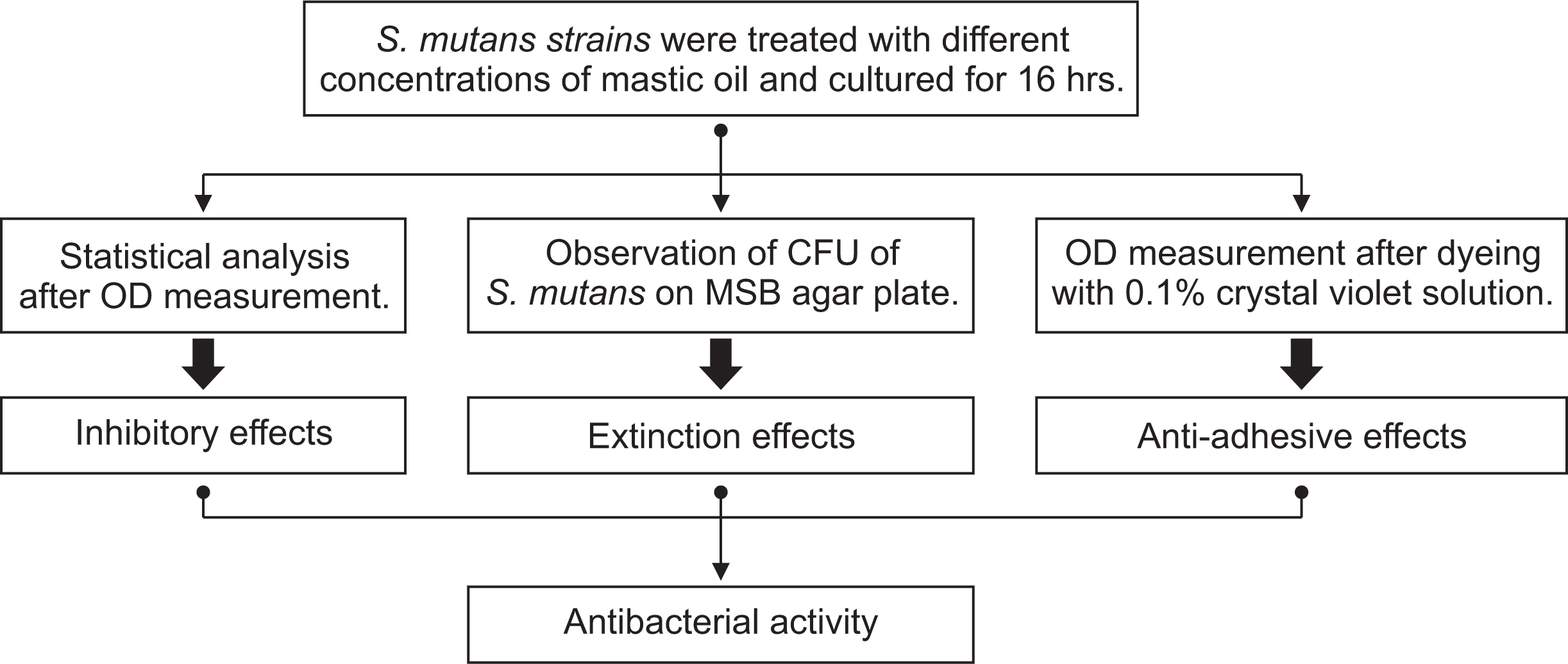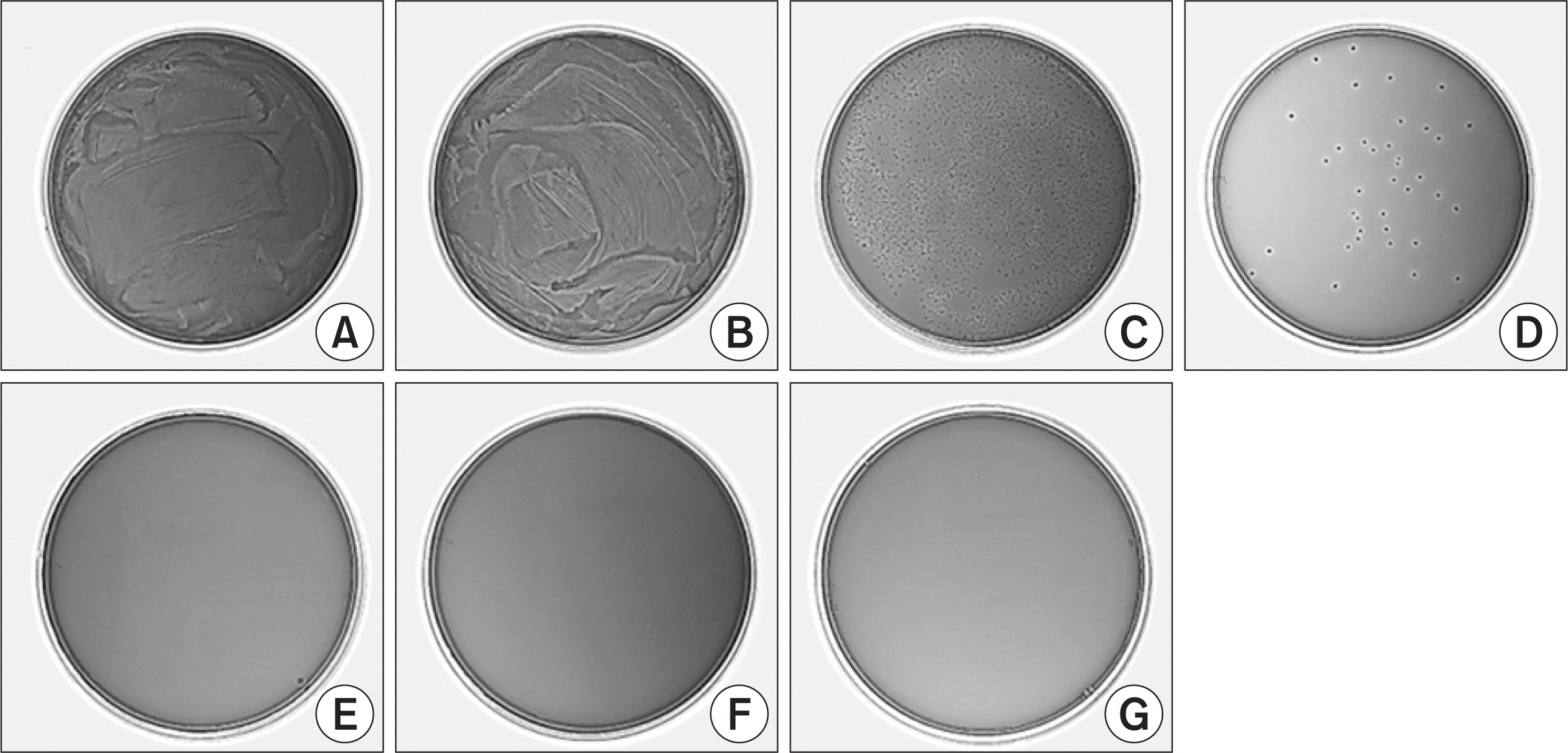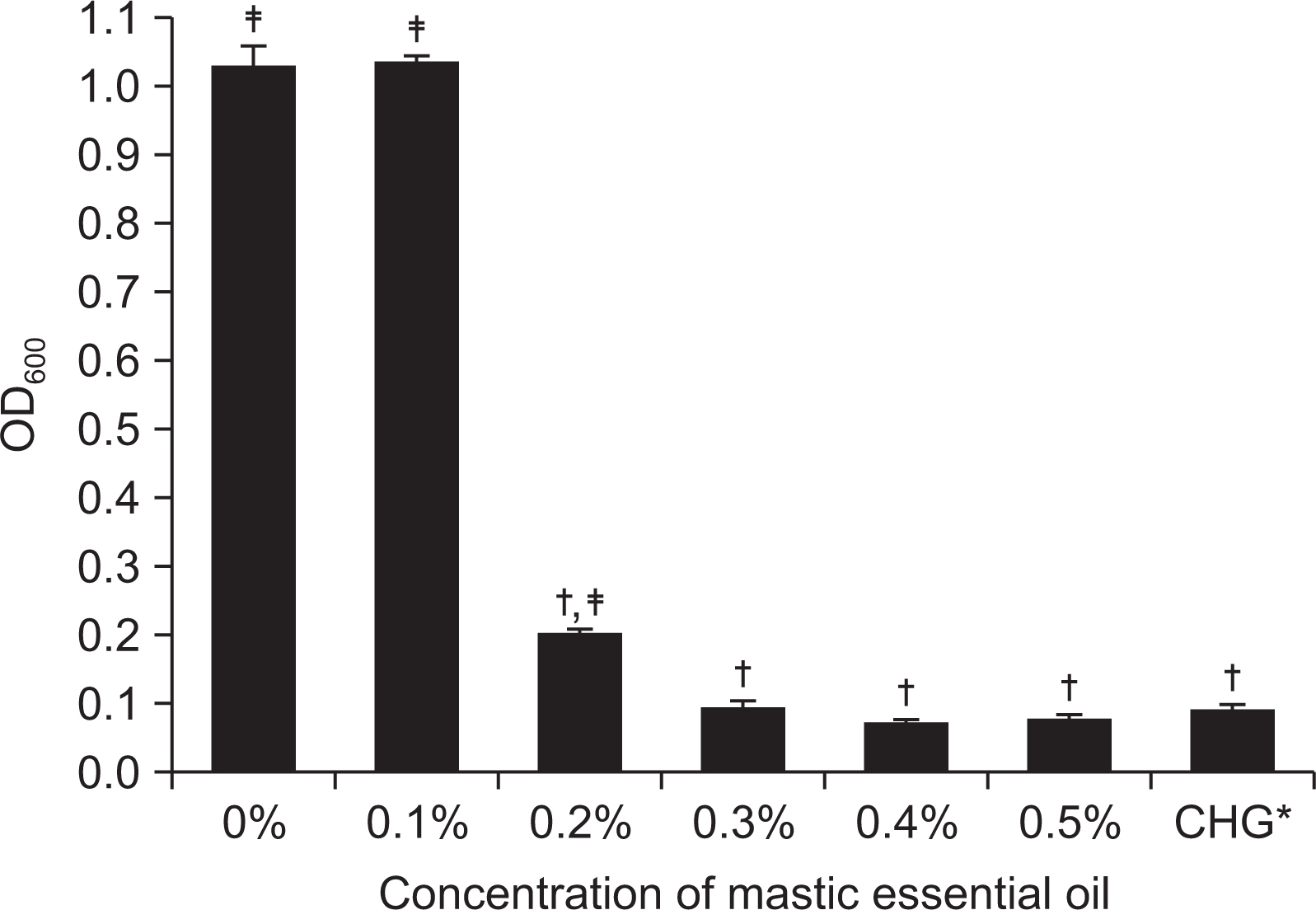J Korean Acad Oral Health.
2020 Dec;44(4):175-179. 10.11149/jkaoh.2020.44.4.175.
Inhibitory effect of mastic oil on Streptococcus mutans growth
- Affiliations
-
- 1Department of Preventive Dentistry, School of Dentistry, Kyungpook National University
- 2Department of Dental Hygiene, College of Science & Technology, Kyungpook National University, Daegu, Korea
- KMID: 2510246
- DOI: http://doi.org/10.11149/jkaoh.2020.44.4.175
Abstract
Objectives
The aim of this study was to examine the antibacterial effect of mastic oil on a representative caries-inducing bacterium, Streptococcus mutans.
Methods
S. mutans UA159 was maintained in a BHI medium containing 0.1% sugar at 37℃ and 10% CO2 . Strains were treated with six different concentrations of mastic oil (0, 0.1, 0.2, 0.3, 0.4, 0.5%). After incubation for 16 h, the antibacterial effect was evaluated by measuring the optical density (OD) and observing the colony-forming unit. A microtiter plate assay was performed to analyze the anti-adhesion ability of mastic oil on S. mutans.
Results
More than 0.1% of mastic oil inhibited the growth of S. mutans. In addition, 0.4% mastic oil exterminated S. mutans. Mastic oil induced an anti-adhesive ability in S. mutans.
Conclusions
These results suggest that mastic oil may be used as a preventive measure against dental caries.
Figure
Reference
-
References
1. Selwitz RH, Ismail AI, Pitts NB. 2007; Dental caries. Lancet. 369:51–59. DOI: 10.1016/S0140-6736(07)60031-2. PMID: 17208642.
Article2. Rosana B, Lamontb RJ. 2000; Dental plaque formation. Microbes Infect. 2:1599–1607. DOI: 10.1016/S1286-4579(00)01316-2. PMID: 11113379.3. Hamada S, Slade HD. 1980; Biology, immunology, and cariogenicity of Streptococcus mutans. Microbiol Rev. 44(2):331–384. DOI: 10.1128/MR.44.2.331-384.1980. PMID: 6446023. PMCID: PMC373181.4. Houte JV. 1994; Role of micro-organisms in caries etiology. J Dent Res. 73(3):672–681. DOI: 10.1177/00220345940730031301. PMID: 8163737.
Article5. Listgarten MA, Korostoff J. Harris NO, Garcia-Godoy F, editors. 2004. The development and structure of dental plaque (A bacterial biofilm), calculus, and other tooth-adherent organic materials. Primary preventive dentistry. 6th ed. Pearson Education Inc.;Jersey: p. 23–44.6. Köhler B, Bjarnason S. 1987; mutans streptococci, lactobacilli and caries prevalence in 11 and 12 year old Icelandic children. Community Dent Oral Epidemiol. 15(6):332–335. DOI: 10.1111/j.1600-0528.1987.tb01747.x. PMID: 3480095.7. Dickson-Spillmann M, Siegrist M, Keller C. 2011; Attitudes toward chemicals are associated with preference for natural food. Food Qual Prefer. 22:149–156. DOI: 10.1016/j.foodqual.2010.09.001.
Article8. Baily LH. 1935; The standard cyclopedia of horticulture, New York. Macmillan. 3:2638–2649.9. Al-Said MS, Ageel AM, Parmar NS, Tariq M. 1986; Evaluation of mastic, a crude drug obtained from Pistacia lentiscus for gastric and duodenal anti-ulcer activity. J Ethnopharmacol. 15(3):271–278. DOI: 10.1016/0378-8741(86)90165-0. PMID: 3724207.10. Al-Habbal MJ, Al-Habbal Z, Huwez FU. 1984; A double-blind controlled clinical trial of mastic and placebo in the treatment of duodenal ulcer. Clin Exp Pharmacol Physio. 11(5):541–544. DOI: 10.1111/j.1440-1681.1984.tb00864.x. PMID: 6395994.
Article11. Huwez FU, Al-Habbal MJ. 1986; Mastic in treatment of benign gastric ulcers. Gastroenterol J pn. 21(3):273–274. DOI: 10.1007/BF02774571. PMID: 3732760.
Article12. Huwez FU, Thirlwell D, Cockayne A, Ala A. 1998; Mastic gum kills Helicobacter pylori. N Engl J Med. 339(26):1946. DOI: 10.1056/NEJM199812243392618. PMID: 9874617.13. Georgiadis I, Karatzas T, Korou LM, Agrogiannis G, Vlachos IS, Pantopoulou A, et al. 2014; Evaluation of chios mastic gum on lipid and glucose metabolism in diabetic mice. J Med Food. 17(3):393–399. DOI: 10.1089/jmf.2013.0069. PMID: 24404977.
Article14. Tzani A, Georgiadis I, Korou LM, Konstantopoulos P, Agrogiannis G, Vlachos I, et al. 2016; Investigation of chios mastic gum effect on metabolic profile in streptozotocin-induced diabetic mice. Atherosclerosis. 252:e95. DOI: 10.1016/j.atherosclerosis.2016.07.552.
Article15. Takahashi K, Fukazawa M, Motohira H, Ochiai K, Nishikawa H, Miyata T. 2003; A pilot study on antiplaque effects of mastic chewing gum in the oral cavity. J Periodontol. 74(4):501–505. DOI: 10.1902/jop.2003.74.4.501. PMID: 12747455.
Article16. Aksoy A, Duran N, Koksal F. 2006; In vitro and in vivo antimicrobial effects of mastic chewing gum against Streptococcus mutans and mutans streptococci. Arch Oral Biol. 51:476–481. DOI: 10.1016/j.archoralbio.2005.11.003. PMID: 16343417.17. Kim JH, Choi JH, Jung YS, Cho MJ, Lee YE, Park DO. 2016; Anticancer effect of mastic on human oral cancer cells. J Korean Acad Oral Health. 40(3):143–148. DOI: 10.11149/jkaoh.2016.40.3.143.
Article18. Tassou CC, Nychas GJE. 1995; Antimicrobial activity of the essential oil of mastic gum (pistacia lentiscus var. chia) on gram positive and gram negative bacteria in broth and in model food system. Int Biodeter Biodegr. 36(3-4):411–420. DOI: 10.1016/0964-8305(95)00103-4.
Article19. Derwich E, Manar A, Benziane Z, Boukir A. 2010; GC/MS analysis and in vitro antibacterial activity of the essential oil isolated from leaf of Pistacia lentiscus Growing in Morocoo. World Appl Sci J. 8(10):1267–1276.20. Karygianni L, Cecere M, Skaltsounis AL, Argyropoulou A, Hellwig E, Aligiannis N, et al. 2014; June. 26. High-level antimicrobial efficacy of representative mediterranean natural plant extracts against oral microorganisms. Biomed Res Int. [Epub]. DOI:10.1155/2014/ 839019. DOI: 10.1155/2014/839019. PMID: 25054150. PMCID: PMC4098616.
Article21. Park CM, Yoon HS. 2018; Anti-bacterial effects of lavender and peppermint oils on Streptococcus mutans. J Korean Acad Oral Health. 42(4):210–215. DOI: 10.11149/jkaoh.2018.42.4.210.22. Hosseini F, Adlgostar A, Sharifinia F. 2013; Antibacterial activity of pistacia atlantica extracts on streptococcus mutans biofilm. Int Res J Biological Sci. 2(2):1–7.23. Liu Y, Zhang X, Wang Y, Chen F, Yu Z, Wang L, et al. 2013; Effect of citrus lemon oil on growth and adherence of streptococcus mutans. World J Microbiol Biotechnol. 29:1161–1167. DOI: 10.1007/s11274-013-1275-7. PMID: 23381618.24. Takarada K, Kimizuka R, Takahashi N, Honma K, Okuda K, Kato T. 2004; A comparison of the antibacterial efficacies of essential oils against oral pathogens. Oral Microbiol Immum. 19:61–64. DOI: 10.1046/j.0902-0055.2003.00111.x. PMID: 14678476.
Article25. Ouhayoun JP. 2003; Penetrating the plaque biofllm: impact of essential oil mouthwash. J Clin Periodont. 30(5):10–12. DOI: 10.1034/j.1600-051X.30.s5.4.x. PMID: 12787196.
- Full Text Links
- Actions
-
Cited
- CITED
-
- Close
- Share
- Similar articles
-
- Antibacterial Effects of Tea Tree Oil and Mastic Oil to Streptococcus mutans
- The growth inhibitory effect of some vegetable oils on Streptococcus mutans and Lactobacillus casei
- Inhibitory Effects of D-mannose on Streptococcus mutans in the Presence of Sucrose
- Anti-bacterial effects of lavender and peppermint oils on Streptococcus mutans
- Inhibitory effects of Coptis chinensis extract on the growth and biofilm formation of Streptococcus mutans and Streptococcus sobrinus




